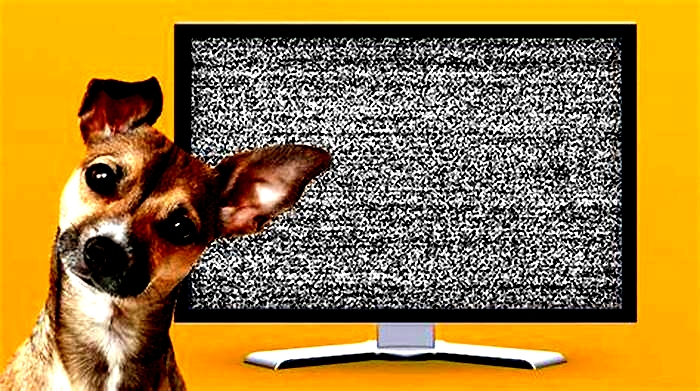Can dogs see TV

What Do Dogs See When They Watch TV?
Have you ever sat down to watch TV, only to have a little furry head pop up and completely block your vision? Is your dog actually watching TV when they sit in front of the screen and stare at it or bark? What exactly is it that attracts your dog to the TV? Can dogs really see TV the way we do? Are they interested in TV shows made for dogs? Lets find out.
Can Dogs See TV?
Dogs absolutely can see TV, and many seem to enjoy it. There are a number of features about television shows that dogs find attractive. Some of these are visual, such as motion, while others relate to the sounds coming from the TV.
Dog eyes are very different from human eyes, so they see things on TV differently. Their vision isnt as sharp, being closer to 20/75 than 20/20, which may explain why they prefer to sit closer to the TV than we doit helps keep the images sharp.
They also have different color perception because they have only two types of color-processing cells in their retinas (we have three). They can only see blues, greens, and yellows, so a dog running on grass with a blue sky behind them, playing with a yellow frisbee, may be very interesting, while a dog sitting next to a red and white picnic table with a red toy would be very dull.
Dogs also have more rods in their eyes than people. Rods are the cells that increase night vision. This means that dogs see very well in the dark and are very sensitive to motion.
Dogs will also perceive the image itself differently, especially on older TVs. Humans dont notice any flickering of images if the screen refresh rate is faster than 55 hertz. However, dogs have better motion perceptionthey will see flickers up to 75 hertz.
So, if we are watching an average TV show at 60 hertz, it will look smooth to us, but the image will appear to flicker for dogs. Fortunately, newer TVs are refreshed at a higher rate, and laptops and desktops have higher refresh rates, so not only do we enjoy a better picture, but so do our pups!
Do Dogs Know That TV Isn't Real?
It is hard to know what dogs are thinking when they watch TV, and some seem to take it much more seriously than others. That being said, it does appear that dogs recognize other animals on TV, will respond to the barking of dogs, and readily distinguish photos of dogs from cartoon dogs.
But dogs also heavily rely on other senses, such as smellwhich clearly isnt possible on a televised image. Based on the disconnect with dogs most important sense (smell), its likely that dogs do recognize that the image on the screen isnt real, but instead a representation of an animal or figure.
That being said, dogs do often respond to the sounds made by animals on TV, and this clearly communicates information to them, even across species lines. So it might be wise to avoid shows involving distressed animals when your dog is sharing screen time.
Why Do Some Dogs Watch TV and Others Don't?
Just like people, dogs will get varying enjoyment out of the TV. Different breeds (and different individual dogs) have differing sight capacity, so some dogs may be able to see what is happening on TV better than others.
If a dog can easily see and recognize a dog chasing something across a screen, they may be more engaged than a dog that relies more heavily on sense of smell or hearing. And some dogs may be more easily fooled by the images on the screen, while others are a little more perceptive in knowing that what they see is not real.
What Kind of TV Shows Do Dogs Like?
In general, dogs will prefer shows that feature animals in motion, and theyd rather see a real animal than a cartoon.
If youd like to test whether your dog is interested in TV, pick a show with very active animalsespecially those your dog is attracted to in real life (such as squirrels, birds, cats, or other dogs). If the colors featured on the screen are shades of blues, yellows, and greens, your dog will be able to see them better.
Then watch your dogs reaction to figure out if they like what they see. Are their eyes following the action? Is their tail happily wagging, or do they seem distressed and growling? Do they seem worried by what they see?
Keep testing shows until you find one that makes your dog happyand then hope that you dont have to fight them over the remote control!
Should You Leave the TV on for Your Dog?
Dogs watching TV has become a thing to the point that there are now channels devoted to dogs and marketing messages that dog TV will calm and relax your dog. Is this true? The jury is out.
More than likely, dogs prefer to watch TV with their owners for companionship. When theyre alone, theyre more likely to just curl up to sleep or do their own thing.
However, if your dog seems to like watching TV, you arent likely doing any harm by leaving it on when you go out or as long as TV time doesnt interfere with playtime, outdoor time, or social time together.
Just hearing the sounds of TV (or even a radio) might be stimulating enough to make the time pass more quickly until you come home. Keep it at a low volume and make sure your dog can move away from the TV if they choose to (for example, if they are crate training or confined to a room with the TV on).
Featured Image: iStock.com/tiffanynorman
Is My Dog Really Watching TV?
Picture this: You're snuggled in for the evening with your dog at your feet, as you catch up on your favorite series, you notice your pup perk up, tilt their head and stare at the TV screen with intent. Then, they bark and wag their tail. They're clearly happy, but what's going on? Do dogs watch TV? Do dogs prefer certain shows? And maybe more importantly, do dogs understand TV?
To answer these questions, we're digging into the science behind a dog's vision and how they process what they see.

Do Dogs Watch TV? And What Do They See?
It's not uncommon for dogs to take an interest in nature shows featuring animals moving about, according to Stanley Coren, PhD, a psychology professor and author of several dog books, including "How Dogs Think" and "The Intelligence of Dogs." On-screen animals must be real to trigger a reaction, though. Cartoon critters just don't spark the interest of our canine friends, Coren says. This is a testament to a dog's ability to accurately interpret what they see.
Do dogs watch TV? Yes, but a pup's vision differs from that of a human. Christopher Pirie, a veterinary ophthalmologist at Cummings School of Veterinary Medicine at Tufts University, says that a dog with normal vision sees at 20/60 compared to our 20/20 rating. So if you're watching TV from 6 feet away, your dog would have to be within 2 feet of the screen to see what you see. The farther they are from the screen, the grainer and fuzzier the video will be. This could be why they lie in front of the TV so often.
Dog eyes also process colors differently than human eyes. For instance, we have three types of color-detecting cells inside our retinas. Dogs only have two, which means they perceive fewer colors with less saturation than the average human. Your furry friend's color range includes dull blue, yellow and green tones. Although limited, this range of vision dispels the notion that pets can only see in black and white.
Veterinary Vision, a California-based pet clinic focused on eye health, says that a dog's ability to see stems from their field of view and several other factors, including their ability to:
- Judge distances
- Detect motion
- Differentiate colors
These abilities vary among dogs based on their health, age and breed. For example, a pup with cataracts won't see clearly; their vision may deteriorate to the point where they only see differences between light and dark, not colors. When this happens, their other senses like smell and hearing will shift into high gear to help them understand what's going on around them. Therefore, if your dog has cataracts and still perks up during movie night, it may be due to their hearing rather than their vision.
What Are Dogs Thinking While They Watch TV?
Now, let's put all this information together, within the context of what your dog is responding to on screens. We know that dogs can see specific colors, hear sounds from the TV and are attracted to movement. They respond to these cues more readily, but is this a good thing? Sure! Just like us, our doggie friends like a little TV entertainment.
In an article for The New York Times, a veterinarian, a psychology professor, and a series of others discuss whether or not dogs should watch TV. It concludes that sitting in front of a screen is not a replacement for outdoor play and exercise, but that it's fine on occasion, especially if your dog experiences separation anxiety. Leaving a TV on while you're away can stimulate your pet's mind, helping them ward off boredom and keeping them happier and relaxed overall.

Try This Simple Experiment With Your Dog
Wondering if your pup has a favorite TV show or movie? Put them on the same level as the screen, allowing them to get as close as they want. You could also place a tablet near your dog's kennel or allow them to rest on a chair that sits at the same height as your TV.
Next, pick a show that features animals being active. These could be dogs, cats, squirrels, birds or any creatures your pup finds intriguing in real life. For the most variety, consider documentaries or channels that focus on animal content. Remember, pets aren't keen on cartoons, so opt for shows featuring real animals. Pay close attention to the colors on the screen. Since dogs see blues, yellows and greens more vividly, you may notice a spike in their attention when they see outdoor scenes with blue skies and green grass. Or, they may perk up when a dog on TV plays with a yellow toy.
Observe your dog's physical reactions and behaviors. Are their eyes following the movement on the screen? Is their tail wagging? Are they growling or barking? Are they pacing? Are they suddenly jumping up and getting more interested in the show? Are they looking to you for reassurance? When you see happy responses, take note of what's on TV. If you notice irritation, pay attention to that, too. Just like humans, dogs have preferences for what they do and do not want to see. Choose shows that elicit happiness and your dog will be one content TV watcher just like you.
So, do dogs watch TV? And do dogs understand TV? They sure do! Watching a show together can be a fun, new way to bond with your canine companion. After a long dog walk or busy puppy play date, why not curl up with your pup and watch something you both enjoy? It's a great way to both relax after a busy day and spend some quality time together. And if your dog doesn't appear interested in television, that is okay too. Simply snuggling on the couch together may be more than enough for both of you.
Contributor Bio

Angela Tague
Angela Tague is a pet mom, writer and yogi living in the Midwest. When she's not making a mess in the kitchen or attending a yoga workshop, she's writing full time for multiple lifestyle and technology brands. You can find her on Twitter and LinkedIn @AngelaTague.
Can Dogs Really See Whats On TV? A Complete Guide
As a canine behavior expert, Im often asked if dogs can actually see and understand television in the same way humans do. With flashing imagery, rapid scene changes, and loud sounds, TV would seem like the perfect thing to captivate your dogs attention.
But since dog vision works very differently compared to human eyes, do our furry friends really see and comprehend images on the screen as we do? Lets dig into the evidence behind dogs and TV.
Notable Differences Between Dog and Human Vision
Human eyes evolved impressive visual acuity, with excellent color perception and ability to see fine details. We have three types of photoreceptor cones, enabling us to distinguish red, green and blue light.
Dogs, on the other hand, have significantly lower visual acuity according to veterinary research. Their color vision is limited to just two channels blue and yellow. This is called dichromatic vision. They are also less able to see crisp details, especially for distant objects.
However, canine vision does have some superior capacities compared to human sight. Dogs enjoy almost 300 degrees of peripheral vision versus our 180 degrees. Dogs can also detect very rapid movements and flickering light better than we can, perceiving rates upwards of 75 Hz compared to our 60 Hz limit.
Notable Differences in Dog and Human Vision
- Dogs have lower visual acuity, lacking sharp detail, especially at a distance
- Dogs only see blue and yellow hues; they have dichromatic color vision
- Dogs have almost 300 degrees peripheral vision, humans only 180 degrees
- Dogs see better in dim light thanks to more rod photoreceptor cells
- Dogs detect flickering light and rapid motion over 75 Hz, faster than humans
What Do Dogs Actually See on TV Screens?
Given their visual limitations, research confirms dogs do not see television images the same way humans do. The picture appears less focused, with muted colors and less fine detail visible. Rapid scene and camera angle changes may appear as flickering light bursts to dogs.
However, multiple studies have shown dogs are able to identify familiar objects, animals, people and actions on TV, despite the visual differences. The sounds coming from the TV also help dogs associate images with real-life objects and events.
Key Factors in How Dogs Perceive TV Images
- Less visual detail and color depth perception
- Quick scene cuts may look like flickering light to dogs
- Still able to recognize familiar objects, animals, people and actions
- Auditory cues help associate sounds with corresponding images
Breed Tendencies Which Dogs Watch TV Most?
Many factors influence whether a dog pays attention to a TV screen or ignores it completely. One key factor seems to be breed tendencies.
According to a survey of over 1,000 dog owners by Dutch company DogTV, breeds relying more on vision and movement for hunting, like terriers and hounds, are significantly more likely to notice and react to TV compared to scent-driven breeds like bloodhounds and beagles.
Herding breeds, including border collies and Australian cattle dogs, also frequently respond to moving objects and animals they see on television, wanting to "herd" the on-screen creatures. These breeds watch TV more than others.
Breeds That Tend to Watch TV Most
- Terriers Jack Russell, Yorkshire, Cairn, etc.
- Hounds Greyhound, whippet, borzoi
- Herding breeds Border collie, cattle dog, sheltie
- Sporting breeds Spaniels, retrievers, pointers
Why Some Dogs Love Watching Animal Shows
Its very common for dogs to be highly interested in TV shows featuring other animals. But what makes tuning into critters on screen so much more engaging than human programs?
According to canine researchers, there are three main factors that draw dogs into animal content:
1. Movement
The vision center in a dogs brain is highly responsive to motion. TV shows with animals naturally feature lots of action birds flying, cows charging, cats pouncing. This triggers a dogs instinct to notice and track movement.
2. Sounds
Hearing realistic animal vocalizations like barking, meowing or chirping further engages a dogs auditory interest. They recognize these sounds and closely associate them with the corresponding animal behaviors shown on-screen.
3. Smell
Watching other animals can also stimulate a dogs powerful sense of smell. Though they cant actually smell a TV, studies show dogs often sniff the air when animals appear on-screen, as if expecting real scents. Their olfactory imagination is activated.
In one experiment, over 75% of dogs sniffed the air repeatedly while watching dog or cat footage. But they sniffed far less with shows featuring only human actors.
Do Special Dog TV Channels Really Work?
Recently, TV channels designed specifically for canine viewers have become available. The most popular is DogTV, which programs shows claiming to entertain and relax anxious dogs home alone.
But do these dog TV channels deliver measurable benefits for pets? Many animal experts remain skeptical.
Critiques of dedicated dog TV include:
- No scent or physical interaction misses key canine engagement needs
- Rapid pacing could overstimulate some dogs prone to compulsions
- Synthesized soundtracks meant to soothe humans, not dogs
- No proven lasting calming effect on anxious, stressed dogs
In one study, DogTV only held most dogs interest for an average of 6 minutes before they lost attention or became restless. The channels may distract some bored dogs temporarily, but effects seem short-lived once the show ends.
More peer-reviewed research on these channels impacts is still needed. In the meantime, owners report very mixed results from dog-aimed TV programming.
Potential Benefits and Drawbacks of Dog TV Time
Beyond entertainment, could television viewing also provide developmental or behavioral benefits for dogs? Veterinary behaviorists have mixed opinions on the potential pros and cons.
Possible Benefits
- Provides some mental stimulation and distraction for dogs left alone
- Exposure to novel sounds/sights may help build confidence in fearful dogs
- May briefly help relax some anxious or stressed dogs
- Could aid in training instructional videos demonstrate behaviors
Potential Drawbacks
- Flashing lights overstimulate some dogs, worsening compulsions
- Could increase separation anxiety after TV is turned off
- May reinforce unwanted behaviors like barking at TV animals
- Better enrichment and training options exist than passive TV time
The general veterinary consensus seems to be that television viewing should be limited for dogs, not relied on heavily for enrichment. More interactive play, exercise and training will benefit dogs brains and bodies more than too much couch potato time.
Tips for Making TV Time Safer for Your Dog
If you want to have the TV on when your dog is present, certain guidelines can make it a more positive experience.
- Supervise and pay attention to your dogs reactions at first
- Avoid channels with lots of fast flashes of light
- Do not show aggressive dog fights or similar intense scenes
- Keep TV time limited to prevent overstimulation
- Make sure volume isnt uncomfortably loud for canine ears
- Do not use TV as a substitute for quality time and activity with your dog
Following these tips will help ensure television remains an occasional novelty for your dog rather than an unhealthy obsession or stress trigger.
The Bottom Line on Dogs and TV
Extensive research confirms dogs can and do perceive visual media, engaging with it based on breed tendencies, training and content. But science indicates they likely do not comprehend broader meaning and context on TV.
While television will probably never provide the sensory richness of real interaction, when used in moderation it can offer some dogs cognitive stimulation. As we continue to deepen our understanding of canine psychology and perception, we can keep learning more about how dogs experience our modern media world.









